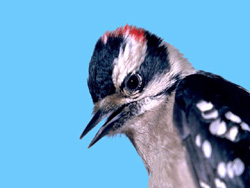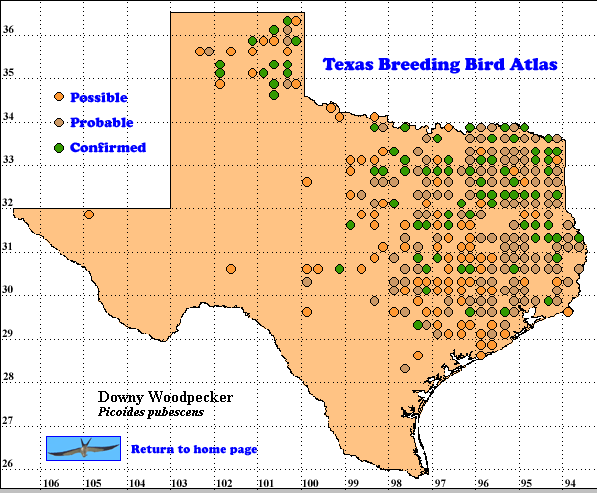Picoides pubescens
The Downy Woodpecker is a fairly common permanent resident throughout much of North America. The A.O.U. Checklist (1998) indicates that it breeds from central Alaska and Canada to southern California, central Texas, and southern Florida. In many places its abundance and relative tolerance for human activities make it one of the most familiar woodpeckers. The BBS indicates that it is especially numerous east of the Great Plains. Christmas Bird Count data show that it is common in winter in the east and that it is absent from the Sonoran Desert and southwestern Texas (Root 1988). It is also one of the very few Texas birds that is not found in Mexico.
Despite the fact that it is a permanent resident the Downy Woodpecker apparently does wander to some extent during the non-breeding season. Oberholser (1974) listed several sight records of individuals considerably south and west of the known breeding range. The TBBAP mapped two out-of-range records, as far southwest as latilong 31104, in the Guadalupe Mountains, over 330km(200mi) from the nearest record. Both are from the post-breeding period (one in late July and one in August) and, in all likelihood represent dispersing, non-breeding individuals.
DISTRIBUTION: The TBBAP records indicate that the Downy Woodpecker in Texas breeds almost exclusively east of the 99th parallel. The exception to this is its surprising occurrence throughout the northern Panhandle with breeding confirmed in 12 sections in this area. This apparently represents a significant range expansion, as Oberholser(1974) reported no breeding and only three summer sight records in the northern Panhandle. It is all but absent from the Edwards Plateau and other highlands in the western part of the state (Kutac 1993). Oberholser(1974) lists one breeding record from the Stockton Plateau, but the TBBAP data did not include any records from this area. However, this may have been due to incomplete coverage in the Trans-Pecos area.
SEASONAL OCCURRENCE: The Downy Woodpecker can be a relatively difficult species to confirm. Only 18% of the 557 total TBBAP records were confirmed records, and only 10 of these confirmations represented active nests with young. No nests with eggs were located, but that is not unusual in a cavity-nesting species.
The breeding season extends from early March to late June. Oberholser(1974) listed egg records from 4 May to 28 May and nearly fledged young 11 April to 20 June. Texas records from the Cornell Laboratory of Ornithology’s North American Nest Record Card Program indicate nest building as early as 4 March and young leaving the nest as late as the end of June. The TBBA nest records, with young, are all confined to the period from 21 April to 30 May. Some authors mentioned the possibility that this species is double brooded in the south (Harrison 1975, Ehrlich et.al 1988), but the TBBAP records do not provide any evidence to support this.
BREEDING HABITAT: The Downy Woodpecker is a cavity-nesting species and, like most woodpeckers, excavates a new hole each year in which to raise its young. The hole can be drilled in a live or dead tree or even a fence post (Harrison 1975). The nest is often camouflaged with fungus, lichen, and moss and lined with wood chips (Ehrlich et al 1988, Kilham 1983). Recently, researchers in eastern Texas have found that the Downy Woodpecker will accept polystyrene snags for roosting holes, but it will not nest in them (Conner and Saenz 1996). Its favorite haunts are woodlands and parklike areas (Bent 1964). In Texas the Downy Woodpecker is quite adaptable in its choice of breeding sites and has been reported nesting in woodlands, residential areas, isolated trees in cow pastures, and a variety of other habitats. It breeds in both riparian and upland woodlands (Kutac & Caran 1994). In urban areas this bird could hybridize with the Ladder-backed Woodpecker (Sexton 1986, Short 1971).
STATUS: The Downy Woodpecker’s status in Texas is very good and the bird has moved into new areas in the past twenty years. The overall distribution as revealed by the TBBAP data is similar to that reported by Oberholser (1974) with the exception of the northern Panhandle region. The TBBAP found the Downy Woodpecker breeding regularly throughout the eastern two thirds of the northern Panhandle, whereas Oberholser (1974) reported no breeding records for this area.
Although BBS data do show a very slight decrease of 0.5% per year for the period from 1966 to 1994 (Sauer et.al. 1996), the Downy Woodpecker seems to be holding its own in Texas. Although it is still generally restricted to the eastern portion of the state, it continues to be fairly common in the areas where it is found. Its outlook in the state is especially good because the Downy Woodpecker is so adaptable and thrives in areas occupied by humans, such as farms, orchards, and residential areas. This adaptability has allowed its abundance to remain stable in many areas of the country. In Pennsylvania, for example, its distribution has remained essentially unchanged from the time of the earliest ornithologists, despite heavy development in that state (Master 1992). Its outlook in Texas appears to be equally as secure.
Text by David E. Fantina (ca. 1999)
Literature Cited
American Ornithologists Union. 1998. Checklist of North American birds, 7th ed. Washington, D.C.
Bent, A. C. 1939. Life histories of North American woodpeckers. U.S. Nat. Mus. Bul., 174.
Conner, R. N. and D. Saenz. 1996. Woodpecker excavation and use of cavities in polystyrene snags. Wilson Bull. 108: 449-456.
Ehrlich, P .R., D. S. Dobkin, and D. Wheye. 1988. The birder’s handbook. Simon & Schuster, New York.
Harrison, H. H. 1975. A field guide to bird’s nests. Houghton Mifflin, Boston, MA.
Kilham, L. 1983. Life history studies of woodpeckers of eastern North America. Publ. Nuttall Ornithol. Club no. 20.
Kutac, E. A. 1993. Birders guide to Texas. Gulf Publ, Houston.
Kutac, E. A. and S .C. Caran. 1994. Birds and other wildlife of south central Texas. University of Texas Press, Austin.
Master, T. L. 1992. Downy Woodpecker. Pp. 186-187 in Atlas of breeding birds in Pennsylvania (D.W. Brauning, ed.).
Oberholser, H. C. 1974. The bird life of Texas. University of Texas Press, Austin.
Root, T. 1988. Atlas of wintering North American birds. The University of Chicago Press, Chicago, IL.
Sauer, J. R., B. G. Peterjohn, S. Schwartz, and J. E. Hines. 1996. The North American breeding bird survey home page. Version 95.1. Patuxent Wildlife Research Center, Laurel, MD. (Accessed 30 August, 1998).
Sexton, C. W. 1986. A possible hybrid Ladder-backed x Downy Woodpecker in central Texas. Bull. Texas Ornithol. Soc. 19: 2-5.
Short, L. L. 1971. Systematics and behavior of some North American woodpeckers, genus Picoides (Aves). Bull. Amer. Mus. Nat. Hist. 145: 1-118.

